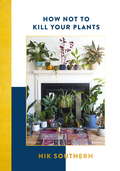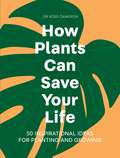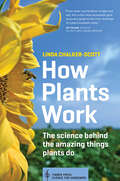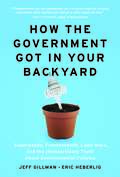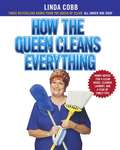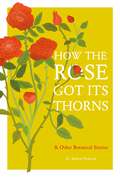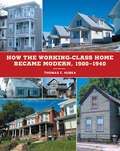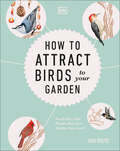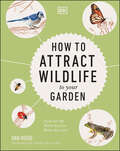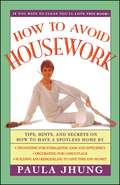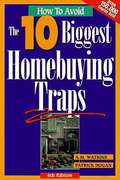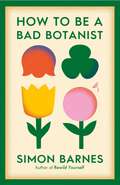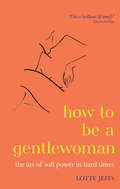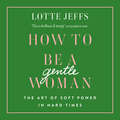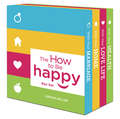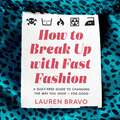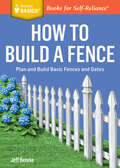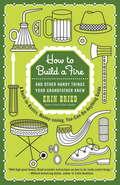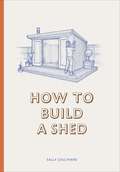- Table View
- List View
How Not To Kill Your Plants: Know, Grow And Style
by Nik SouthernHands up if you've killed a plant? Yep, me too. It's no secret that we've all become plant obsessed, but do we really understand how to look after them? I am not a Professor of Botany, but having run my florist and plant shop, Grace & Thorn, since 2011 I've learnt a few things along the way. HOW NOT TO KILL YOUR PLANTS is about taking the hocus-pocus out of plants and flowers and enabling you to understand a plant's needs in order to know where to place and how to style them, but most importantly how to keep them alive.I get asked every type of question you can imagine and I have written this book to answer them. Watering can down, it's time to go back to the roots.Keep it green.Nik x(AKA The Agony Plant)
How Not To Kill Your Plants
by Nik SouthernHands up if you've killed a plant? Yep, me too. It's no secret that we've all become plant obsessed, but do we really understand how to look after them? I am not a Professor of Botany, but having run my florist and plant shop, Grace & Thorn, since 2011 I've learnt a few things along the way. HOW NOT TO KILL YOUR PLANTS is about taking the hocus-pocus out of plants and flowers and enabling you to understand a plant's needs in order to know where to place and how to style them, but most importantly how to keep them alive.I get asked every type of question you can imagine and I have written this book to answer them. Watering can down, it's time to go back to the roots.Keep it green.Nik x(AKA The Agony Plant)
How Plants Can Save Your Life: 50 Inspirational Ideas for Planting and Growing
by Ross CameronGrowing plants and (if we are lucky enough) creating gardens is deeply rewarding, but has also been proven to be vital for our health.Gardening helps improve our mood, relax us, take us away from our everyday problems, and promote positive emotions. It reduces anxiety and stress, delays in the onset of dementia, promotes joy, as well as improving physical health and even self-esteem.This new book explores the ways we can introduce plants into our lives and thus embrace some of the benefits the natural world provides for our well-being. Divided into 50 sections, each one highlights a plant-based activity, how this is good for your health and provides links to the underlying concept that supports health and well-being.Written by a leading scientific authority on environmental horticulture, this unique book will offer readers a wealth of ideas on planting and growing as well as explaining the latest science research behind those ideas.
How Plants Can Save Your Life: 50 Inspirational Ideas for Planting and Growing
by Ross CameronGrowing plants and (if we are lucky enough) creating gardens is deeply rewarding, but has also been proven to be vital for our health.Gardening helps improve our mood, relax us, take us away from our everyday problems, and promote positive emotions. It reduces anxiety and stress, delays in the onset of dementia, promotes joy, as well as improving physical health and even self-esteem.This new book explores the ways we can introduce plants into our lives and thus embrace some of the benefits the natural world provides for our well-being. Divided into 50 sections, each one highlights a plant-based activity, how this is good for your health and provides links to the underlying concept that supports health and well-being.Written by a leading scientific authority on environmental horticulture, this unique book will offer readers a wealth of ideas on planting and growing as well as explaining the latest science research behind those ideas.
How Plants Work: The Science Behind the Amazing Things Plants Do (Science For Gardeners Ser.)
by Linda Chalker-ScottThe more you know, the better you grow! Plants are capable of interesting and unexpected things. Why do container plants wilt when they’ve been regularly watered? Why did the hydrangea that thrived last year never bloom this year? Why do slugs wipe out the vegetable garden instead of eating the weeds? Plant physiology—the study of how living things function—can solve these and most other problems gardeners regularly encounter.In How Plants Work, horticulture expert and contributor to the popular blog The Garden Professors, Linda Chalker-Scott brings the stranger-than-fiction science of the plant world to vivid life. She uncovers the mysteries of how and why plants do the things they do, and arms the home gardener with fascinating knowledge that will change the way they garden.
How the Government Got in Your Backyard: Superweeds, Frankenfoods, Lawn Wars, and the (Nonpartisan) Truth About Environmental Policies
by Jeff Gillman Eric HeberligBiotechnology—the future or a genetic time bomb? Renewable fuels—the key to cleaner air or just corporate welfare? Greenhouse gasses—baking the earth to death or just a needless worry? Plant patents—improving gardens and farms or just profiteering? When you stop to think about it, the government has its hand in every important environmental issue. And with the left and the right raucously disagreeing about whether the government’s policies are for good or for evil, it’s impossible for a concerned citizen to know what to think.How the Government Got in Your Backyard distills the science, the politics, and the unbiased, nonpartisan truth behind hot-button environmental issues from pesticides to global warming. By clearly representing what the left says, what the right says, what the science is, and what the facts are, Gillman and Heberlig don’t set out to provide the answer—they light the path so concerned citizens can uncover their own true and informed opinion. In this season of political discontent, the unbiased truth about environmental policies—free of political agendas—is as refreshing as it is fascinating.How the Government Got in Your Backyard is not for Republicans or Democrats, liberals or conservatives. It’s for anyone who is ready to get to the bottom line.
How the Queen Cleans Everything: Handy Advice for a Clean House, Cleaner Laundry, a
by Linda CobbA how-to manual for housekeeping amateurs and pros alike, How the Queen Cleans Everything is a collection of fast and ingenious tips from #1 New York Times bestselling author -- and housekeeping's royal lady -- Linda Cobb, the Queen of Clean®. It's all here. All of the Queen's miraculous tips and surprising shortcuts on how to solve hundreds of cleaning challenges -- inside and out. Let the Queen show you how to turn your home into a sparkling palace in no time at all. Learn how to put an end to washday drudgery with her collection of nifty and natural solutions for stress-free washing and ironing -- and enjoy a year's worth of tips, tricks, and picks for a cleaner house and a more organized life. But most of all, discover how the Queen's no-nonsense "tips and hints" method of housekeeping means less time cleaning your home, and more time enjoying it! Let the Queen show you: the best way to clean your kitchen and bathroom the multitude of natural stain removers that are hiding in your cupboard how to garden the natural way what to do for spots, stains, scorch marks, and odors why you shouldn't clean your windows with newspaper how to clean your carpet and bare floors the right way to allergy-proof your home what those care labels really mean how to treat troublesome stains and delicate fabrics...and much more! At last...all the Queen of Clean's® famous advice for a clean house, cleaner laundry, and a year of timely tips -- right at your fingertips! Don't be home without it!
How the Rose Got Its Thorns: And Other Botanical Stories
by Dr Andrew OrmerodHave you ever wondered why the rose has thorns and other flowers don't; why the daffodil is the colour it is; or why some plants have shiny leaves and others matt?How The Rose Got its Thorns reveals the inner workings of our favourite flowers and trees. Designed to help gardeners, both novice and experienced, better understand how plants grow, the book is easy to navigate - it is divided into 50 chapters, each one a story.Accompanied by specially commissioned colour illustrations, each chapter explains the science behind how plants work and the extraordinary processes they have evolved: such as protecting themselves from predators using chemicals; attracting pollinators using scent, shape and colour; growing in low or high temperatures; their relationship with the wind; the size and pattern of their leaves; the distribution of their seeds and survival strategies; their relationship with insects; how they allocate their resources; and how they retain water efficiently.This delightful and intriguing book offers readers an accessible way to better understand how our plants evolved into the species of today.
How the Rose Got Its Thorns: And Other Botanical Stories
by Dr Andrew OrmerodHave you ever wondered why the rose has thorns and other flowers don't; why the daffodil is the colour it is; or why some plants have shiny leaves and others matt?How The Rose Got its Thorns reveals the inner workings of our favourite flowers and trees. Designed to help gardeners, both novice and experienced, better understand how plants grow, the book is easy to navigate - it is divided into 50 chapters, each one a story.Accompanied by specially commissioned colour illustrations, each chapter explains the science behind how plants work and the extraordinary processes they have evolved: such as protecting themselves from predators using chemicals; attracting pollinators using scent, shape and colour; growing in low or high temperatures; their relationship with the wind; the size and pattern of their leaves; the distribution of their seeds and survival strategies; their relationship with insects; how they allocate their resources; and how they retain water efficiently.This delightful and intriguing book offers readers an accessible way to better understand how our plants evolved into the species of today.
How the Working-Class Home Became Modern, 1900–1940 (Architecture, Landscape and Amer Culture)
by Thomas C. HubkaThe transformation of average Americans&’ domestic lives, revealed through the mechanical innovations and physical improvements of their homes At the turn of the nineteenth century, the average American family still lived by kerosene light, ate in the kitchen, and used an outhouse. By 1940, electric lights, dining rooms, and bathrooms were the norm as the traditional working-class home was fast becoming modern—a fact largely missing from the story of domestic innovation and improvement in twentieth-century America, where such benefits seem to count primarily among the upper classes and the post–World War II denizens of suburbia. Examining the physical evidence of America&’s working-class houses, Thomas C. Hubka revises our understanding of how widespread domestic improvement transformed the lives of Americans in the modern era. His work, focused on the broad central portion of the housing population, recalibrates longstanding ideas about the nature and development of the &“middle class&” and its new measure of improvement, &“standards of living.&”In How the Working-Class Home Became Modern, 1900–1940, Hubka analyzes a period when millions of average Americans saw accelerated improvement in their housing and domestic conditions. These improvements were intertwined with the acquisition of entirely new mechanical conveniences, new types of rooms and patterns of domestic life, and such innovations—from public utilities and kitchen appliances to remodeled and multi-unit housing—are at the center of the story Hubka tells. It is a narrative, amply illustrated and finely detailed, that traces changes in household hygiene, sociability, and privacy practices that launched large portions of the working classes into the middle class—and that, in Hubka&’s telling, reconfigures and enriches the standard account of the domestic transformation of the American home.
How to Attract Birds to Your Garden: Foods they like, plants they love, shelter they need
by Dan RouseHelp your local wild birds by providing them with a safe garden environmentMake a difference to your local birdlife. Help reverse the decline in bird numbers by creating a haven in which they will thrive. It's a win-win. Provide the best shelter, feeding, and nesting opportunities for them and then you can reap the rewards as they sing and entertain.No need to be an expert gardener already, or to break the bank - many of the most beneficial features can be installed easily and cheaply, and many you can build yourself or upcycle to be eco-friendly.
How to Attract Wildlife to Your Garden: Foods They Like, Plants They Love, Shelter They Need
by Dan RouseTransform your garden into a haven for all kinds of wildlife.In a world with too much concrete and not enough greenery, every wildlife-friendly garden can make a huge difference. But what if we told you that you can make a difference to your local wildlife from the comfort of your own home? You can help to reverse the decline in bird numbers and much more by creating a haven in which they will thrive! Let author, presenter, and wildlife conservationist Dan Rouse show you how you can make your outdoor space more welcoming for a wide variety of visitors, from planting pollinator-friendly perennials to digging a pond. Learn the best ways to provide shelter, food, and water, discover the best planting choices and how they can help, then sit back and watch as your garden becomes a much-needed refuge for a huge range of species.Dive straight in to discover:- A beautiful mixture of full-color illustrations and photos of different species.- Practical advice on supporting local wildlife, with ideas suitable for all budgets and abilities.- Suggestions for beneficial plant choices for a range of climate and soil types.- Step-by-step projects tailored to both attracting wildlife and to observe the wildlife that visits the garden.- Ideas for small gardens and outdoor spaces, as well as practical considerations such as pets and children sharing a garden with wildlife.- Final chapter on &‘Observing garden wildlife&’ that showcases low- and high-tech methods of watching for wildlife, and how to connect with the wider wildlife community. The book features plenty of projects to help you attract and observe your new garden visitors, as well as galleries of common species you can expect to see. Following in the footsteps of its sister title How to Attract Birds to Your Garden, everything in the book is clear, accessible, and engaging, with plenty of budget-friendly tips and ideas suitable for gardeners and non-gardeners alike. Packed with equal parts expertise and passion, How to Attract Wildlife to Your Garden proves that, by giving nature opportunities to thrive, we all benefit: ourselves, our planet, and the wildlife that may call our garden home.
How to Avoid Housework: Tips, Hints and Secrets to Show You How to Have a
by Paula JhungHousehold tips by a popular columnist include fast tidy jobs for unexpected visitors, organizing clutter, creating a self-maintained kitchen, coping with mess-makers, and keeping the bathroom clean.If you think it’s not possible to have a virtually self-cleaning home—think again! America’s self-proclaimed “#1 Avoidance Expert” tells all in this often hilarious, always smart, and eminently practical compendium of tips, hints, and secrets to maintaining a spotless home by barely lifting a finger. Would you rather arrange flowers and light candles than dust the table they sit upon? Would you rather sweep the dust under the rug than vacuum it? Here at last, in this terrific “antihousework” bible, Paula Jhung blends artful advice, a soupcon of illusion, and a bucketful of wit to whip up super solutions for the “I Hate to Housekeep” brigade. Sweeping (quickly) through every room in the house, Jhung gives you the dirt.
How to Avoid the Ten Biggest Home-Buying Traps
by Patrick Hogan A. M. WatkinsBuying a house can be a wonderful experience if you understand not only what to buy, but also what not to buy. But can you avoid common homebuying mistakes if you don't know what they are? Let How to Avoid the 10 Biggest Homebuying Traps guide you safely through the process of buying your home by showing you what pitfalls to identify and sidestep. With this guidance, you can successfully navigate potential money traps to find the home of your dreams. How To Avoid the 10 Biggest Homebuying Traps reveals the ten most common, and costly, mistakes homebuyers make. Guided by real estate expert Art Watkins, you'll learn how to spot and avoid: Houses that are overpriced for their value New construction by shady builders Homes that are marginal in quality Houses packed with special features for an impulse buy Garbled floor plans that reduce a home's value Homes that are expensive energy guzzlers, and much more.
How to be a Bad Botanist
by Simon BarnesCan you tell a tomato from a grape? Lawn from an oak tree? Then congratulations - you are a botanist. Self-confessed bad birdwatcher Simon Barnes thought he knew nothing about plants. He didn't object to them: trees are interesting, because birds perch in them; plants are useful as they create habitats and birds live in habitats. But while admiring the tenacity of some sea kale and yellow-horned poppy to thrive on an inhospitable shingle beach, he was struck by a truth - it all begins with plants. In this funny and inspiring book, Simon Barnes tells the story of a lifelong relationship with plants, and the realisation of the fact. Taking us from thinking ourselves ignorant about plants, to gently starting to observe seasons, patterns and places, Barnes guides us on a journey to better observing the beauty and diversity of the natural world. Both a primer on how to appreciate the plants around us and an exploration on how they make our external and interior worlds, How to be a Bad Botanist opens our eyes to the wonders around us. Plants are everywhere, in every part of your life, and you know more than you think.
How to be a Gentlewoman: The Art of Soft Power in Hard Times
by Lotte Jeffs*'This is brilliant and timely' Elizabeth Day'Part memoir, part manual - this is the type of book every modern woman can take something from' GraziaLearn to navigate the harshness of life with soft power. In her debut book, Lotte Jeffs weaves powerful life experience with practical advice and a psychological deep-dive into what truly constitutes an emotionally rich and meaningful existence. She speaks to everyone from agony aunts and archaeologists, to pop stars and novelists, to explore a diverse picture of what it is to truly live life well.How to be a Gentlewoman will teach you how to slow down, lean out, recognize good relationships and let go of the bad, create a space you love, find your people and construct a happy and 'joined up' sense of yourself.The gentle antidote to a brutal world.For fans of Dolly Alderton's Everything I Know About Love and Elizabeth Day's How to Fail.
How to be a Gentlewoman: The Art of Soft Power in Hard Times
by Lotte Jeffs*'This is brilliant and timely' Elizabeth Day'Part memoir, part manual - this is the type of book every modern woman can take something from' GraziaLearn to navigate the harshness of life with soft power. In her debut book, Lotte Jeffs weaves powerful life experience with practical advice and a psychological deep-dive into what truly constitutes an emotionally rich and meaningful existence. She speaks to everyone from agony aunts and archaeologists, to pop stars and novelists, to explore a diverse picture of what it is to truly live life well.How to be a Gentlewoman will teach you how to slow down, lean out, recognize good relationships and let go of the bad, create a space you love, find your people and construct a happy and 'joined up' sense of yourself.The gentle antidote to a brutal world.For fans of Dolly Alderton's Everything I Know About Love and Elizabeth Day's How to Fail.
The How to Be Happy Box Set
by Sophie KellerTake charge of your happiness, one tip at a time, and make this year your happiest yet.Happiness expert and life coach Sophie Keller will show you how to change your health, love life, marriage and home with easily tailored tips you can use to cater to your individual needs.You'll discover:- How putting a mirror on your fridge can help you lose weight- How to attract a date-anywhere, anytime- Why disagreeing can actually be good for your relationship- Simple feng shui principles to make your home a healthier, happier place to live
How To Break Up With Fast Fashion: A guilt-free guide to changing the way you shop – for good
by Lauren Bravo'A funny, achievable guide' Observer'Lauren Bravo is one of my favourite writers' Dolly Alderton'Bravo will inspire you to repair, recycle and give old items a new lease of life' StylistYou probably know the statistics: global clothing production has roughly doubled in just 15 years, and every year an estimated 300,000 tonnes of used clothing ends up in UK landfill.Fast fashion is the ultimate toxic relationship. It's bad news for the planet, our brains and our bank balances. We can't go on like this; our shopping habits need an overhaul.Journalist Lauren Bravo loves clothes more than anything, but she's called time on her affair with fast fashion in search of a slower, saner way of dressing. In this book, she'll help you do the same.How To Break Up With Fast Fashion will help you to change your mindset, fall back in love with your wardrobe and embrace more sustainable ways of shopping - from the clothes swap to the charity shop. Full of refreshing honesty and realistic advice, Lauren will inspire you to repair, recycle and give your unloved items a new lease of life without sacrificing your style.Because fashion belongs to everyone, but no outfit should cost us the earth.
How To Break Up With Fast Fashion: A guilt-free guide to changing the way you shop – for good
by Lauren Bravo'A funny, achievable guide' Observer'Lauren Bravo is one of my favourite writers' Dolly Alderton'Bravo will inspire you to repair, recycle and give old items a new lease of life' StylistYou probably know the statistics: global clothing production has roughly doubled in just 15 years, and every year an estimated 300,000 tonnes of used clothing ends up in UK landfill.Fast fashion is the ultimate toxic relationship. It's bad news for the planet, our brains and our bank balances. We can't go on like this; our shopping habits need an overhaul.Journalist Lauren Bravo loves clothes more than anything, but she's called time on her affair with fast fashion in search of a slower, saner way of dressing. In this book, she'll help you do the same.How To Break Up With Fast Fashion will help you to change your mindset, fall back in love with your wardrobe and embrace more sustainable ways of shopping - from the clothes swap to the charity shop. Full of refreshing honesty and realistic advice, Lauren will inspire you to repair, recycle and give your unloved items a new lease of life without sacrificing your style.Because fashion belongs to everyone, but no outfit should cost us the earth.
How To Break Up With Fast Fashion: A guilt-free guide to changing the way you shop – for good
by Lauren BravoYou probably know the statistics: global clothing production has roughly doubled in just 15 years, and every year an estimated 300,000 tonnes of used clothing ends up in UK landfill. Fast fashion is the ultimate toxic relationship. It's bad news for the planet, our brains and our bank balances. We can't go on like this; our shopping habits need an overhaul.Journalist Lauren Bravo loves clothes more than anything, but she's called time on her affair with fast fashion in search of a slower, saner way of dressing. In this book, she'll help you do the same. How To Break Up With Fast Fashion will help you to change your mindset, fall back in love with your wardrobe and embrace more sustainable ways of shopping - from the clothes swap to the charity shop. Full of refreshing honesty and realistic advice, Lauren will inspire you to repair, recycle and give your unloved items a new lease of life without sacrificing your style. Because fashion belongs to everyone, but no outfit should cost us the earth. (P)2020 Headline Publishing Group Ltd
How to Build a Fence: Plan and Build Basic Fences and Gates. A Storey BASICS® Title (Storey Basics)
by Jeff BenekeWhether you want to protect your garden, provide a safe enclosure for pets, or add privacy, this Storey BASICS® guide covers you everything you need to know to build the perfect fence. Offering clear step-by-step instructions, Jeff Beneke shows you how to construct a variety of fences from wood, vinyl, and chain link. With designs that are easily adaptable to all types of yards, you’ll soon be putting up a functional and beautiful fence that works with your landscape.
How to Build a Fire: And Other Handy Things Your Grandfather Knew
by Erin BriedA HANDY GUIDE FULL OF HOW-TO TIPS AND SAGE ADVICE FROM GRANDFATHERS As members of the Greatest Generation, our grandfathers were not only defined by the Depression but also by their heroic service to the country in World War II. Courageous, responsible, and involved, they understand sacrifice, hard work, and how to do whatever is necessary to take care of their loved ones. They also know how to have a rollicking good time. Sensible, fun, and inspiring,How to Build a Fireoffers a rare glimpse into the hearts and minds of grandfathers near and far by sharing their practical skills and sweet stories on how to be stronger, smarter, richer, and happier. Inside are more than one hundred essential step-by-step tips for fixing, leading, prospering, playing, and hosting, including how to bull; buck up and be brave in the face of adversity bull; play hard and break in a baseball mitt bull; bait a hook and catch a big fish bull; look dapper and tie a perfect tie bull; get a raise and earn more bull; write a love letter and kindle romance bull; change a flat tire and save the day bull; stand up and give a sparkling toast bull; play the harmonica and make your own music Loaded with charming illustrations, good humor, and warm nostalgia,How to Build a Fireis the perfect handbook for guys or gals of any age. The first of its kind, this collection of our grandfathers' hard-earned wisdom will help you build confidence and get back to what's really important in life.
How to Build a House with an Architect
by John M. BakerBuilding a house with an architect should be fun. The experience should be one of the most exciting and creative efforts in one's entire life. It can only be so, however, if the client and the architect enjoy that special rapport that comes from understanding how a house is designed and constructed.
How to Build a Shed
by Sally CoulthardEver dreamed of having your very own garden retreat? Off-the-shelf sheds aren’t always the answer - the cheap ones are badly made and freezing cold, and the better quality ones are really expensive. But what if you could build your own shed from scratch? How to Build a Shed is the ultimate practical guide. With its clear, easy-to-follow instructions, expert advice and specially commissioned illustrations, you'll be able to source the materials, choose the right tools and build your dream shed on a budget - even if you’ve never used a hammer.
